Joshua Samuel Brown's Blog, page 4
February 24, 2017
Eye Scream for Ice Cream
I'm officially pitching the slogan Taiwan: Expect the Unexpected to the Taiwan Tourism Bureau.
Our recent travels have convinced Stephanie of what I've always known about Taiwan, namely that the Taiwanese have an amazing knack for doing weirdly creative stuff.
Yesterday morning we were driving into Taichung from Nantou with my friend Simon figuring out what to do in Taichung on what's quickly turning into an unfavorably chilly day.
"Hey, I can take you to an eye hospital," Simon says, or at least that's what I thought he said.
"My eyes are fine." I reply, figuring that I've misunderstood the Chinese.
"No, It used to be an eye hospital. A long time ago. Now they sell Ice Cream."
Anywhere else, this concept would seem a strange connection, but in Taiwan I've learned to Expect the Unexpected.
So off we went to the Miyahara Eye Hospital, a beautifully restored and re-purposed Japanese colonial era building that sold, among other things, gourmet ice cream. We made this film.
Astute viewers will note that I'm flashing my new name-card holder emblazoned with the Chinese characters for Taiwan. The holder was a gift from a small company in Tainan called Rachin (link here) that manufactures custom made name-card holders, luggage tags & other items. Even more astute viewers may notice the lovely cut-out silhouette of Taiwan itself, through which the cartoon avatar of yours truly peeks through.
Our recent travels have convinced Stephanie of what I've always known about Taiwan, namely that the Taiwanese have an amazing knack for doing weirdly creative stuff.
Yesterday morning we were driving into Taichung from Nantou with my friend Simon figuring out what to do in Taichung on what's quickly turning into an unfavorably chilly day.
"Hey, I can take you to an eye hospital," Simon says, or at least that's what I thought he said.
"My eyes are fine." I reply, figuring that I've misunderstood the Chinese.
"No, It used to be an eye hospital. A long time ago. Now they sell Ice Cream."
Anywhere else, this concept would seem a strange connection, but in Taiwan I've learned to Expect the Unexpected.
So off we went to the Miyahara Eye Hospital, a beautifully restored and re-purposed Japanese colonial era building that sold, among other things, gourmet ice cream. We made this film.
Astute viewers will note that I'm flashing my new name-card holder emblazoned with the Chinese characters for Taiwan. The holder was a gift from a small company in Tainan called Rachin (link here) that manufactures custom made name-card holders, luggage tags & other items. Even more astute viewers may notice the lovely cut-out silhouette of Taiwan itself, through which the cartoon avatar of yours truly peeks through.
Published on February 24, 2017 18:37
February 18, 2017
Yunlin: Lanterns and Puppets
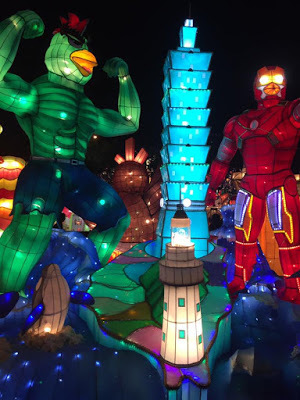 Yunlin Lantern Festival 21017Sunday Morning the Play Bar guest house (note to people who stay at guest houses and use Axe Body Spray: The commercials are lying to you. Sorry for the early mid-introductory sentence digression) after an insanely cool Saturday in Huwei, Yunlin county that featured a full day of puppetry followed by a colorful and chaotic night at the Yunlin lantern festival.
Yunlin Lantern Festival 21017Sunday Morning the Play Bar guest house (note to people who stay at guest houses and use Axe Body Spray: The commercials are lying to you. Sorry for the early mid-introductory sentence digression) after an insanely cool Saturday in Huwei, Yunlin county that featured a full day of puppetry followed by a colorful and chaotic night at the Yunlin lantern festival. Without a doubt, this was the second Craziest festival I've ever attended (Tainan's Beehive Bottle Rocket Festival still ranks as the first - here's a story I did about that one for Lonely Planet).
Actually, the lantern festival is (in some ways) more intense, due mostly to the fact that the fireworks festival has a tendency to focus one's instincts on survival in a way that the lantern festival doesn't quite necessitate. Colorful floats and lanterns, a giant Taiwanese puppet show, music, acrobats and amazingly good food.
We got there just before sundown, and stopped for food at the ad hoc night market set up outside of the actual festival grounds. With tons of food stalls, games of chance and the usual carnival atmosphere, it would have been easy to have mistaken this "pre-festival" area for the festival itself. Stephanie is not the biggest fan of the night market atmosphere, but she made the best of it by pretending that there was a Dave Matthews concert happening just around the bend.
After we spent about a half an hour just walking through this food market, killing time before the festival itself and eating, I pointed at the lights and lanterns in the distance and informed Stephanie that this was the actual festival. A good time was had by all, and full details of the event will be written up in Formosa Moon (Things Asian Press, 2018. More details here.)
Leaving in a few for some exploration. In keeping with the theme of visiting parts of Taiwan I've not yet seen, we are going to hitchhike to the town of Gukeng, noted for it's greenery, scenery and coffee farms. More soon.
Published on February 18, 2017 17:57
Formosa Moon: Yunlin Lanterns, Puppets and Coffee
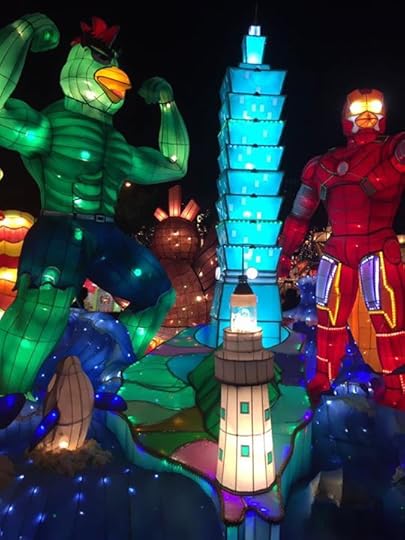

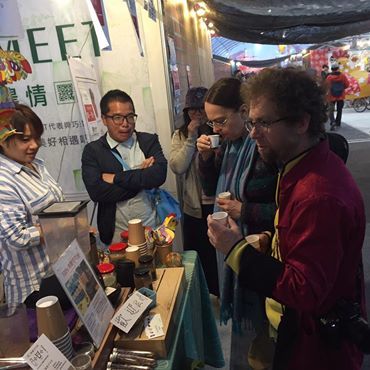 Sunday Morning the Play Bar guest house (note to people who stay at guest houses and use Axe Body Spray: The commercials are lying to you. Sorry for the early mid-introductory sentence digression) after an insanely cool Saturday in Huwei, Yunlin county that featured a full day of puppetry followed by a colorful and chaotic night at the Yunlin lantern festival. Without a doubt, this was the second Craziest festival I've ever attended (Tainan's Beehive Bottle Rocket Festival still ranks as the first - here's a story I did about that one for Lonely Planet).
Sunday Morning the Play Bar guest house (note to people who stay at guest houses and use Axe Body Spray: The commercials are lying to you. Sorry for the early mid-introductory sentence digression) after an insanely cool Saturday in Huwei, Yunlin county that featured a full day of puppetry followed by a colorful and chaotic night at the Yunlin lantern festival. Without a doubt, this was the second Craziest festival I've ever attended (Tainan's Beehive Bottle Rocket Festival still ranks as the first - here's a story I did about that one for Lonely Planet). Actually, the lantern festival is in someways more intense, due mostly to the fact that the fireworks festival has a tendency to focus one's instincts on survival in a way that the lantern festival doesn't quite necessitate. Colorful floats and lanterns, a giant Taiwanese puppet show, music, acrobats and amazingly good food.
We got there just before sundown, and stopped for food at the ad hoc night market set up outside of the actual festival grounds. With tons of food stalls, games of chance and the usual carnival atmosphere, it would have been easy to have mistaken this "pre-festival" area for the festival itself.
Stephanie is not the biggest fan of the night market atmosphere, but she made the best of it by pretending that there was a Dave Matthews concert happening just around the bend. After we spent about a half an hour just walking through this food market, killing time before the festival itself and eating, I pointed at the lights and lanterns in the distance and informed Stephanie that this was the actual festival.
A good time was had by all, and full details of the event will be written up in Formosa Moon (Things Asian Press, 2018. More details here.)
Leaving in a few for some exploration. In keeping with the theme of visiting parts of Taiwan I've not yet seen, we are going to hitchhike to the town of Gukeng, noted for it's greenery, scenery & coffee farms. More soon.
Published on February 18, 2017 17:57
February 17, 2017
Formosa Moon: An Apology to Yunlin County
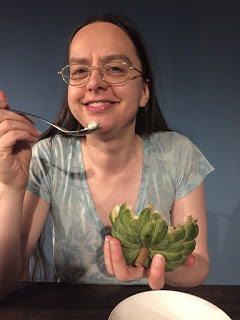 Stephanie eating a Buddha Head FruitOK, a confession: When I first started laying out the general route for the Formosa Moon Trip, my original intention was to find a few of what we guidebook writers call "Points of Interest" in each of Taiwan's counties. I'm more familiar with some areas of Taiwan than others, and in these places I had no shortage of exploration ideas. For others I went by memory, places I'd visited in years past but didn't spend much time in. In a few places I put out feelers to the greater Taiwan collective..."Where's someplace in Pingtung worth visiting that hasn't been written about much," that sort of thing.
Stephanie eating a Buddha Head FruitOK, a confession: When I first started laying out the general route for the Formosa Moon Trip, my original intention was to find a few of what we guidebook writers call "Points of Interest" in each of Taiwan's counties. I'm more familiar with some areas of Taiwan than others, and in these places I had no shortage of exploration ideas. For others I went by memory, places I'd visited in years past but didn't spend much time in. In a few places I put out feelers to the greater Taiwan collective..."Where's someplace in Pingtung worth visiting that hasn't been written about much," that sort of thing.And then there's Yunlin, a county whose existence I'd been so vaguely aware of that I actually forgot to put it on the list all together.
(It's here I ought to note that my geographic-chapter responsibility for my first Lonely Planet was Taipei and the outer islands, with co-author Robert Kelly covering the rest of the island. So he had the greater responsibility by land mass, while I covered the lion's share population-density wise.)
I was on the phone with my buddy Simon in Nantou (we're heading there in a couple of days - Hello Simon!) just a few weeks before leaving Portland, and I was running through my chapter ideas with him.
"Yunlin." He said, "You forgot anything about Yunlin."
So I did some research and found a couple of cool spots I wanted to check out here, and figured that we'd visit them for the book in between other more well-known spots.
But something interesting happened - which is why I'm writing this post from the town of Huwei, in Yunlin County, where Stephanie and I have spent a delightful day and plan on spending at least another day and a half.
Angela is a friend of ours from Beitou, Taipei who shares our love for Potehi (or Boteshi, as its sometimes spelled), Taiwanese Glove Puppetry. And as soon as she found out about this shared passion, she suggested that we make Yunlin a main stop on the Formosa Moon tour because Yunlin, in addition to being the home of the world famous Pili International Multimedia, creators of several of Taiwan's esteemed glove puppetry TV shows, is also home to the Yunlin Hand Puppet Museum.
So, long story short, we decided to spend the weekend here, heading down from Taipei this afternoon and tomorrow we'll be meeting up with Angela to spend the day meeting the master puppeteers and checking out the museum itself.
And Huwei is turning out to be a pretty hopping spot. The town has a gentle vibe, and the food is good. (I'm a big fan of goose, and there are a number of good places in town serving that, as well as the Chiayi turkey rice from the next county over.) After checking into our guest house (the very cool Play Bar, a nicely decorated spot located inside of an otherwise unremarkable residential building not far from the museum) we strolled around and chatted bamboo, art and gardening with the folks running the Yunlin Story House, a Japanese colonial era building that's been turned into an interactive arts space. Like many towns in this part of Taiwan, it's a great place for fruit (though to be fair, the Buddha head fruit in the photo above was probably imported from Taitung).
There's a major lantern festival going on this month just outside of town (we'll be heading there after the museum tomorrow - apparently there's a three-story high puppet among the lanterns), so while we're planning to see more of Yunlin outside of Huwei (coffee farms!), we'll probably be here until at least Sunday afternoon.
To bring it full circle, I'm sorry for not finding Yunlin sooner. And I'd also like to apologize for Floyd's harassment of this kind woman at a local turkey rice place down the block from the museum. (She was a good sport!)
Published on February 17, 2017 07:13
February 8, 2017
Formosa Moon: Catching Up
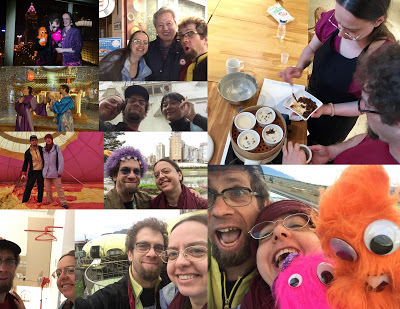 Fun around FormosaForgive the pause between blog posts & the skip in timeline continuity. Since our last post the Formosa Moon Trek has taken us on quite the cultural journey.
Fun around FormosaForgive the pause between blog posts & the skip in timeline continuity. Since our last post the Formosa Moon Trek has taken us on quite the cultural journey.We've experienced Taitung from every angle - overland, high above (see last post), under (snorkeling in Green Island) and up and down the coast (several times). We even went to a a traditional Taiwanese Weiya, an experience that definitely goes into the book (Imagine a three hour long game show/variety show/banquet...that, my friend, is a weiya).
Following our experiences in Taitung, we headed over to Tainan ("The Portland of Taiwan") where we were hosted at the most excellent Jia Jia West Market Hotel; part hotel, part museum, the Jia Jia proved to be in the top five most unique hotels in which I've ever stayed, which given my profession says a lot.
From Tainan, we headed straight back to Taipei (with a brief stopover in Taichung to visit my friend Simon) via bullet train to set up our home office. Settling back down in our home in the mountains outside of Taipei has proven time consuming. Our new apartment is beautiful, sunny and, except for an unpolished Ming dynasty chair came completely unfurnished.The apartment is unique, to say the least, almost as vertical as it is horizontal, with many stairs connecting various levels. Our bathroom is immaculate, yet slightly awkwardly designed. complete with a raised toilet built into the wall; the toilet, which is approached via a stone step, is an interesting counterpoint to the Ming chair in the living room.
We've spent the better part of the last two weeks shopping and scavenging - luckily, we live in an area where scavenging for second hand furniture is popular (there's even a group in the area that uses the LINE app as sort of a digital swap-meet space).
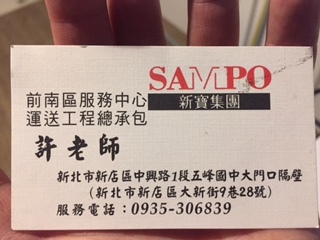 Friendly Neighborhood Second Hand ShopThanks to the second-hand group, a chance meeting with a discerning collector of items named Huang, a few manic trips to Carrefour and yet another chance meeting, this one with an excellent handyman who sells masterfully refurbished second hand appliances from a shop in Xindian (I can't recommend his services highly enough - bought a fridge and oven from him & he not only brought them & us up the hill, he threw in a number of other items including a lovely red cushion for our Ming Dynasty chair, which loses as many points for comfort as it gains in style), our Honeytrekkers compound / home / office is now fully furnished.
Friendly Neighborhood Second Hand ShopThanks to the second-hand group, a chance meeting with a discerning collector of items named Huang, a few manic trips to Carrefour and yet another chance meeting, this one with an excellent handyman who sells masterfully refurbished second hand appliances from a shop in Xindian (I can't recommend his services highly enough - bought a fridge and oven from him & he not only brought them & us up the hill, he threw in a number of other items including a lovely red cushion for our Ming Dynasty chair, which loses as many points for comfort as it gains in style), our Honeytrekkers compound / home / office is now fully furnished.And now, pending some serious organization and a few more multi-week trips to spots near and remote, The Real Work Begins.
Stay tuned!
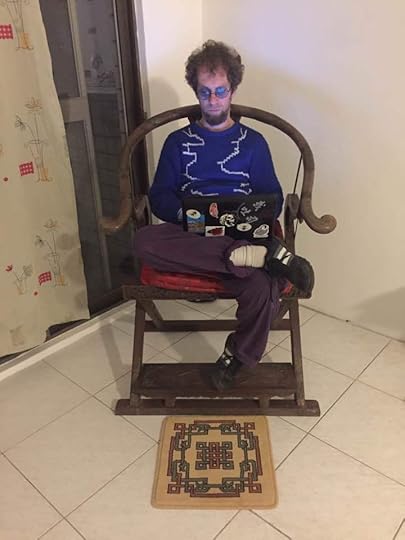 The Famous Ming Chair
The Famous Ming Chair
Published on February 08, 2017 05:21
January 19, 2017
Formosa Moon: Up Over Taitung
The day began with a 5:15 wake-up call. Please file "Hot Air Ballooning is generally done only in the hours after dawn and before dusk" in the "information I only recently learned" category. If a picture is worth a thousand words then a video is worth ten thousand, so if that's your thing click here for the short video we made during the launch. As for how much a Facebook Live feed is worth, well...it might be too early to tell, but we did one of those, too, and you can check it out here.
But just in case you don't feel like watching either video, some pictures and words. First, the words:
Ballooning over Taitung's rift valley (that's the place where the Asia & Philippine tectonic plates have been crashing into each other in slow motion since time began, or pretty damn close to it; more on geological specifics in the book) was an amazing, absolutely breathtaking experience, and easily among the most awesome things I've ever done. That Taitung has become a center for recreational ballooning is no accident - the area is perfect for it, and I'll wax more eloquently about the experience in print, both for the book and for an article I'm hoping to pen after attending the month-long Taitung hot air balloon festival this July. And last but not least, thanks to everyone at SkyRainbow Airline Balloon who not only made the experience happen, but didn't bat an eye when Stephanie and I whipped out puppets mid-flight.
So for now, pictures:
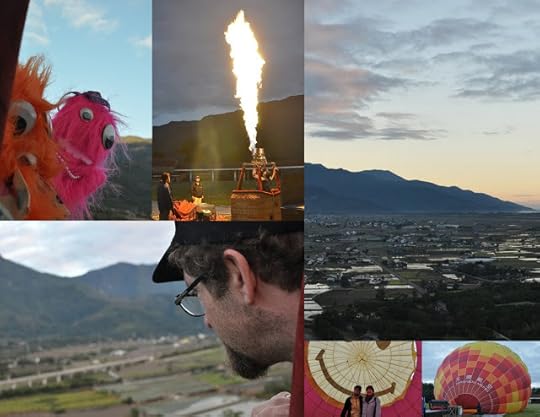 "Ye Old Collage"Special thanks to everyone who made this amazing day happen, including Sky Rainbow Airline for the balloon flight (Their website is http://www.skyrainbow.com.tw/, but you'll also find them on Facebook at https://www.facebook.com/skyrainbow.c...).
"Ye Old Collage"Special thanks to everyone who made this amazing day happen, including Sky Rainbow Airline for the balloon flight (Their website is http://www.skyrainbow.com.tw/, but you'll also find them on Facebook at https://www.facebook.com/skyrainbow.c...).
More - oh so much more - to come, both on this blog and in Formosa Moon, to be published by Things Asian Press in February, 2018. Click here for more details.
But just in case you don't feel like watching either video, some pictures and words. First, the words:
Ballooning over Taitung's rift valley (that's the place where the Asia & Philippine tectonic plates have been crashing into each other in slow motion since time began, or pretty damn close to it; more on geological specifics in the book) was an amazing, absolutely breathtaking experience, and easily among the most awesome things I've ever done. That Taitung has become a center for recreational ballooning is no accident - the area is perfect for it, and I'll wax more eloquently about the experience in print, both for the book and for an article I'm hoping to pen after attending the month-long Taitung hot air balloon festival this July. And last but not least, thanks to everyone at SkyRainbow Airline Balloon who not only made the experience happen, but didn't bat an eye when Stephanie and I whipped out puppets mid-flight.
So for now, pictures:
 "Ye Old Collage"Special thanks to everyone who made this amazing day happen, including Sky Rainbow Airline for the balloon flight (Their website is http://www.skyrainbow.com.tw/, but you'll also find them on Facebook at https://www.facebook.com/skyrainbow.c...).
"Ye Old Collage"Special thanks to everyone who made this amazing day happen, including Sky Rainbow Airline for the balloon flight (Their website is http://www.skyrainbow.com.tw/, but you'll also find them on Facebook at https://www.facebook.com/skyrainbow.c...).More - oh so much more - to come, both on this blog and in Formosa Moon, to be published by Things Asian Press in February, 2018. Click here for more details.
Published on January 19, 2017 05:00
January 15, 2017
Formosa Moon: Green Island
Barely seven PM and we're already in bed in our room at the Simple, friendly and clean Yu Fu (Fisherman) guesthouse (0919-127-976) because a) it's cold, b) we've got a date with the sunrise at a hot spring named for the sunrise, and c) there's not much else to do on Green Island on a Sunday night in winter. And if there is, nobody's told us about it.
It's my third trip to Green Island in two decades and Stephanie's first (obviously), and the place is is windy and beautiful and compellingly forlorn as it was the first time I came and ran into a transvestite impersonating the then-Vice President of Taiwan, Annette Lu. Home to Taiwan's notorious martial law era political prison, Green Island also boasts excellent snorkeling (saw lots of fish and coral despite the rough weather), one of the world's only sea water hot springs (called Sun Rise Hot Springs, for very good reason), and of course more prison-and-fish related attractions than you can shake a stick at, if that's your thing.
The boat ride over was treacherous as always. Not for nothing did I dub the boat doing the run Green Island Vomit Comet, and this morning's trip out didn't disappoint. Only some excellent medicine and years of Vupassana practice (done in this case lying on our backs on the cushions provided) kept me from the hell of 50 minutes of throwing up that's traditionally been my entrance ticket to the island. (Useful tip: Sit in the back and lie down.)
After visiting the prison (about which I'll write more in the book), we headed to lunch (seafood congee, a safe choice for the celiacs suffering Stephanie, whose first bad meal in two weeks came a ta Mosburger, "rice hamburger" be damned) and then headed out to do some snorkeling.
The winds were high, and the sea rough - not ideal snorkeling weather, but we'd been loaned padded wet suits. Stephanie had a wonderful time and stayed in the full hour, but I'd had a dream the night before involving death by drowning, and being conscious of the power of omens chose to stick warily to the rocky shore. There is good snorkeling to be done here, and I plan to come back in the summer to do so.
After snorkeling, we rented an electric scooter - there are thousands on the island, purchased no doubt in the optimistic frenzy for Chinese tourist dollars that now seems a distant money-laden but ill-mannered mirage - and took a tour around the island to the sound of increasing wind and rain.
Green Island is beautiful and slightly unearthly, and as I'm passing out I'll let the images do the talking.
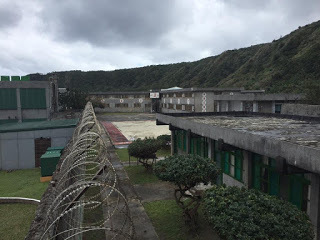
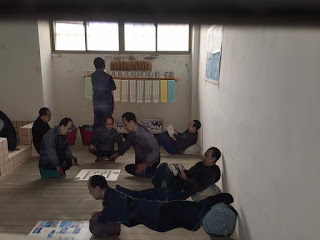
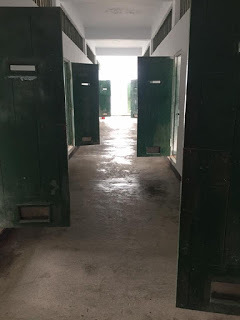
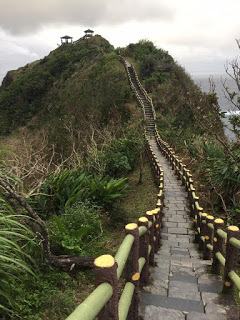
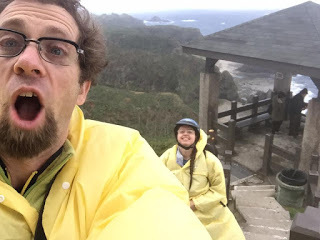
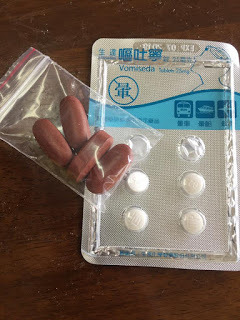
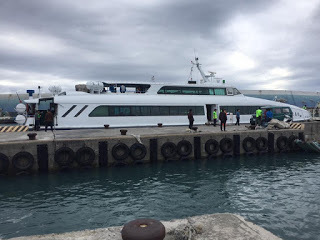
(More in Formosa Moon, available from Things Asian Press, 2018)
It's my third trip to Green Island in two decades and Stephanie's first (obviously), and the place is is windy and beautiful and compellingly forlorn as it was the first time I came and ran into a transvestite impersonating the then-Vice President of Taiwan, Annette Lu. Home to Taiwan's notorious martial law era political prison, Green Island also boasts excellent snorkeling (saw lots of fish and coral despite the rough weather), one of the world's only sea water hot springs (called Sun Rise Hot Springs, for very good reason), and of course more prison-and-fish related attractions than you can shake a stick at, if that's your thing.
The boat ride over was treacherous as always. Not for nothing did I dub the boat doing the run Green Island Vomit Comet, and this morning's trip out didn't disappoint. Only some excellent medicine and years of Vupassana practice (done in this case lying on our backs on the cushions provided) kept me from the hell of 50 minutes of throwing up that's traditionally been my entrance ticket to the island. (Useful tip: Sit in the back and lie down.)
After visiting the prison (about which I'll write more in the book), we headed to lunch (seafood congee, a safe choice for the celiacs suffering Stephanie, whose first bad meal in two weeks came a ta Mosburger, "rice hamburger" be damned) and then headed out to do some snorkeling.
The winds were high, and the sea rough - not ideal snorkeling weather, but we'd been loaned padded wet suits. Stephanie had a wonderful time and stayed in the full hour, but I'd had a dream the night before involving death by drowning, and being conscious of the power of omens chose to stick warily to the rocky shore. There is good snorkeling to be done here, and I plan to come back in the summer to do so.
After snorkeling, we rented an electric scooter - there are thousands on the island, purchased no doubt in the optimistic frenzy for Chinese tourist dollars that now seems a distant money-laden but ill-mannered mirage - and took a tour around the island to the sound of increasing wind and rain.
Green Island is beautiful and slightly unearthly, and as I'm passing out I'll let the images do the talking.







(More in Formosa Moon, available from Things Asian Press, 2018)
Published on January 15, 2017 03:42
January 11, 2017
Formosa Moon 2: Back in Jiaoxi
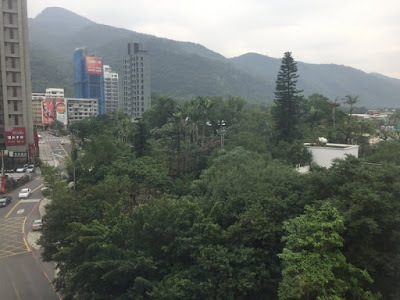 Jiaoxi from our hotel windowOur Treasure Island Honeymoon, having left Taipei's gravity, has brought us to the hot-spring town of Jiaoxi in Yilan county ("The county next door", I once called it). A few words on blog-book-project order are in order, because necessity is the mother of invention (and Zappa's Mothers of Invention shaped my childhood).
Jiaoxi from our hotel windowOur Treasure Island Honeymoon, having left Taipei's gravity, has brought us to the hot-spring town of Jiaoxi in Yilan county ("The county next door", I once called it). A few words on blog-book-project order are in order, because necessity is the mother of invention (and Zappa's Mothers of Invention shaped my childhood). The travel writer experience and creation cycle is a tricky balance. Many years ago I had the good fortune to travel alongside Michael Palin as he researched a small chunk of his book & TV show Himalaya, and was most impressed with his diligence, specifically with how he sat and took notes before dinner each day.
But Michael did his schooling in Britain, whereas I'm the product of City-As-School, the alternative high school in New York City that produced two of the three Beastie Boys, a band well known for taking ample time for creative stewing between musical projects.
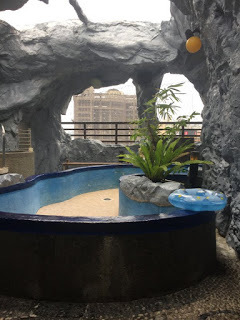 Cavern-themed rooftop spaSuffice to say that a) Stephanie, a good mid-western girl, is taking notes the old fashioned way (with pen and ink), and b) this blog may wind up being less than sequential, like a Vonnegut novel.
Cavern-themed rooftop spaSuffice to say that a) Stephanie, a good mid-western girl, is taking notes the old fashioned way (with pen and ink), and b) this blog may wind up being less than sequential, like a Vonnegut novel. With this in mind, we have now been in Taiwan for nine days, and awoke this morning at a quite pleasant hot spring hotel called Tian Long Hotel. (Here's their website - the cavern-themed rooftop spa is quite groovy.)
I've been coming to Jiaoxi for more years than I can remember. One of my earliest visits was when I was still inspecting factories for a living, and it was to Jiaoxi (or however they were spelling it back in 1999), when I stumbled to town drunkenly after a particularly memorable drinking binge in Yilan City. I'd decided to make a game of stopping into every restaurant offering Japanese food for a small bottle of sake and a piece of sea urchin to see how far I'd get. (The answer, for readers interested in this sort of thing, was the bathtub of a hotel in Jiaoxi. The hotel no longer seems to be open, saving me from having to return to apologize to the maid).
Jiaoxi is known for hot springs, and was a favorite spot for the Japanese military (their appreciation of hot springs was one of their more benign traits in the early 20th century) during the occupation years, and is also one of mine. It seemed a natural first stop outside of Taipei for the journey, both for logistic and seduction purposes, since the main purpose of the trip is to get Stephanie to fall in love with Taiwan.
But Jiaoxi has changed much since I sought drunken refuge here on a dark evening in the late nineties. It has grown, upwards and outwards, with new high-rise buildings - some hotels, and some apartments - spreading out both north and south.
Jiaoxi, like many areas in Taiwan traditionally considered tourism areas, has found tourism to be a double-edged sword. The town underwent a major building boom to accommodate the rising tide of tourists from China during the Ma Ying-jeou years. But the steady stream dried to a trickle after the inauguration of Tsai Ing-wen last year, Beijing having decided to show their displeasure with the new administration by applying pressure on Taiwan's tourism industry, and now vacancies are high. To make matters worse for Jiaoxi's hoteliers (at least according to the owner of the Tian Long), many of the newer luxury apartment buildings on the eastern edge of town are filled with AirBnB rentals, putting further pressure on hotels both old and new.
Some say that Jiaoxi has lost its small town charm. Not Stephanie, though. Having just spent a week in Taipei (which she confessed to finding overwhelmingat times), Jiaoxi feels downright sedate to her.
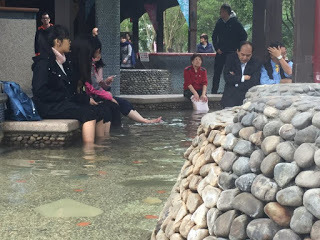 Just another afternoon in Jiaoxi parkAfter checking into our hotel, we soaked our feet along with a few dozen other people in the public park next to our hotel before heading into town for lunch. Though seafood (and pressed smoked duck) are the area's specialties, I was enticed by a sign in the window of a hot-pot place advertising farm-to-table organic vegetables at a che dao bao (eat until full) price of NT268. ) We stopped in, and were greeted by a youngish man lacking a farmer's bearing who directed us to a long table on which a wide variety of local vegetables was laid.
Just another afternoon in Jiaoxi parkAfter checking into our hotel, we soaked our feet along with a few dozen other people in the public park next to our hotel before heading into town for lunch. Though seafood (and pressed smoked duck) are the area's specialties, I was enticed by a sign in the window of a hot-pot place advertising farm-to-table organic vegetables at a che dao bao (eat until full) price of NT268. ) We stopped in, and were greeted by a youngish man lacking a farmer's bearing who directed us to a long table on which a wide variety of local vegetables was laid. "Did you grow these?" I asked him.
"No, my grandmother did." The young man said, pointing to a wizened old woman clipping vegetables on one of the restaurants tables. "All the vegetables are from our family farm, 100% organic."
The meal was good and a welcome breath of wholesomeness after several days of extremely rich hotel fare at the Grand Hyatt (write-up of this experience pending), and the restaurant's farm-to-table nature fit in well with the theme of agricultural tourism, which, in addition to being a current buzz-phrase in Yilan, is also one of the themes we'll be exploring in Formosa Moon. That and puppetry of course.
More on all this later, in the book itself, to be published by Things Asian Press, 2018. In the meantime, some practical information from this post, lest I be accused of neglecting my duty as a guidebook writer.
The Website for the Tien Long Hotel is in Chinese, but we got our room from Hotels.com for about USD$62 a night.
And here, a handy photo collage with Chinese name and phone number of the farm-to-table Hot Pot place in Jiaoxi.

Published on January 11, 2017 03:57
Back in Jiaoxi
 Jiaoxi from our hotel windowOur Treasure Island Honeymoon, having left Taipei's gravity, has brought us to the hot-spring town of Jiaoxi in Yilan county ("The county next door", I once called it). A few words on blog-book-project order are in order, because necessity is the mother of invention (and Zappa's Mothers of Invention shaped my childhood).
Jiaoxi from our hotel windowOur Treasure Island Honeymoon, having left Taipei's gravity, has brought us to the hot-spring town of Jiaoxi in Yilan county ("The county next door", I once called it). A few words on blog-book-project order are in order, because necessity is the mother of invention (and Zappa's Mothers of Invention shaped my childhood). The travel writer experience and creation cycle is a tricky balance. Many years ago I had the good fortune to travel alongside Michael Palin as he researched a small chunk of his book & TV show Himalaya, and was most impressed with his diligence, specifically with how he sat and took notes before dinner each day.
But Michael did his schooling in Britain, whereas I'm the product of City-As-School, the alternative high school in New York City that produced two of the three Beastie Boys, a band well known for taking ample time for creative stewing between musical projects.
 Cavern-themed rooftop spaSuffice to say that a) Stephanie, a good mid-western girl, is taking notes the old fashioned way (with pen and ink), and b) this blog may wind up being less than sequential, like a Vonnegut novel.
Cavern-themed rooftop spaSuffice to say that a) Stephanie, a good mid-western girl, is taking notes the old fashioned way (with pen and ink), and b) this blog may wind up being less than sequential, like a Vonnegut novel. With this in mind, we have now been in Taiwan for nine days, and awoke this morning at a quite pleasant hot spring hotel called Tian Long Hotel. (Here's their website - the cavern-themed rooftop spa is quite groovy.)
I've been coming to Jiaoxi for more years than I can remember. One of my earliest visits was when I was still inspecting factories for a living, and it was to Jiaoxi (or however they were spelling it back in 1999), when I stumbled to town drunkenly after a particularly memorable drinking binge in Yilan City. I'd decided to make a game of stopping into every restaurant offering Japanese food for a small bottle of sake and a piece of sea urchin to see how far I'd get. (The answer, for readers interested in this sort of thing, was the bathtub of a hotel in Jiaoxi. The hotel no longer seems to be open, saving me from having to return to apologize to the maid).
Jiaoxi is known for hot springs, and was a favorite spot for the Japanese military (their appreciation of hot springs was one of their more benign traits in the early 20th century) during the occupation years, and is also one of mine. It seemed a natural first stop outside of Taipei for the journey, both for logistic and seduction purposes, since the main purpose of the trip is to get Stephanie to fall in love with Taiwan.
But Jiaoxi has changed much since I sought drunken refuge here on a dark evening in the late nineties. It has grown, upwards and outwards, with new high-rise buildings - some hotels, and some apartments - spreading out both north and south.
Jiaoxi, like many areas in Taiwan traditionally considered tourism areas, has found tourism to be a double-edged sword. The town underwent a major building boom to accommodate the rising tide of tourists from China during the Ma Ying-jeou years. But the steady stream dried to a trickle after the inauguration of Tsai Ing-wen last year, Beijing having decided to show their displeasure with the new administration by applying pressure on Taiwan's tourism industry, and now vacancies are high. To make matters worse for Jiaoxi's hoteliers (at least according to the owner of the Tian Long), many of the newer luxury apartment buildings on the eastern edge of town are filled with AirBnB rentals, putting further pressure on hotels both old and new.
Some say that Jiaoxi has lost its small town charm. Not Stephanie, though. Having just spent a week in Taipei (which she confessed to finding overwhelmingat times), Jiaoxi feels downright sedate to her.
 Just another afternoon in Jiaoxi parkAfter checking into our hotel, we soaked our feet along with a few dozen other people in the public park next to our hotel before heading into town for lunch. Though seafood (and pressed smoked duck) are the area's specialties, I was enticed by a sign in the window of a hot-pot place advertising farm-to-table organic vegetables at a che dao bao (eat until full) price of NT268. ) We stopped in, and were greeted by a youngish man lacking a farmer's bearing who directed us to a long table on which a wide variety of local vegetables was laid.
Just another afternoon in Jiaoxi parkAfter checking into our hotel, we soaked our feet along with a few dozen other people in the public park next to our hotel before heading into town for lunch. Though seafood (and pressed smoked duck) are the area's specialties, I was enticed by a sign in the window of a hot-pot place advertising farm-to-table organic vegetables at a che dao bao (eat until full) price of NT268. ) We stopped in, and were greeted by a youngish man lacking a farmer's bearing who directed us to a long table on which a wide variety of local vegetables was laid. "Did you grow these?" I asked him.
"No, my grandmother did." The young man said, pointing to a wizened old woman clipping vegetables on one of the restaurants tables. "All the vegetables are from our family farm, 100% organic."
The meal was good and a welcome breath of wholesomeness after several days of extremely rich hotel fare at the Grand Hyatt (write-up of this experience pending), and the restaurant's farm-to-table nature fit in well with the theme of agricultural tourism, which, in addition to being a current buzz-phrase in Yilan, is also one of the themes we'll be exploring in Formosa Moon. That and puppetry of course.
More on all this later, in the book itself, to be published by Things Asian Press, 2018. In the meantime, some practical information from this post, lest I be accused of neglecting my duty as a guidebook writer.
The Website for the Tien Long Hotel is in Chinese, but we got our room from Hotels.com for about USD$62 a night.
And here, a handy photo collage with Chinese name and phone number of the farm-to-table Hot Pot place in Jiaoxi.

Published on January 11, 2017 03:57
January 4, 2017
Robert Storey, Lonely Planet Pioneer
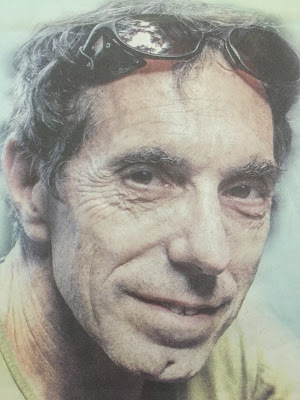 (Excerpted from Taipei Times article, 1/5/17)
(Excerpted from Taipei Times article, 1/5/17)I was on a long-distance train starting an intercontinental journey when I learned of Robert Storey's untimely passing. From what I know of Robert's own life philosophy I think he would have approved of the setting.
Though I never met Robert personally, he was a fellow traveler in the most elemental sense, and his life and work shaped my own in strange and subtle ways.
Robert's guidebooks were among the first I'd ever read, and his stamp was embedded in the first guidebook I ever wrote for Lonely Planet in 2007, an update of a book which he'd originally written. By that time, Storey had become something of a legendary figure, a first-generation Lonely Planet Author who had worked on many of the company's early guides in the pre-internet days when authors still took notes by hand as opposed to computers. It was an honor to cut my teeth for the company on a project bearing so much of Robert Storey's creative DNA, to follow (in some cases, literally) in his own footsteps as a travel writer.
Long before I came on board with Lonely Planet, Robert Storey had achieved something akin to legendary status in Taiwan, and was considered by many in the expatriate community an accomplished adventurer and old Taiwan hand. But to me, Storey was an enigma. While I knew him through his reputation and work, our paths had never crossed, either physically or on the internet. Unlike my own generation of travel writer, Robert didn't keep a blog, and his presence on social media seemed limited to a few posts a month on Facebook.
A few months back as I began preparing for another book project (a more leisurely literary trip around Taiwan than my usual guidebook output), I put out a few digital feelers in an attempt to connect with Robert. I thought it would be good - fitting, even - to finally meet this person whose professional life had so intersected with my own. Robert got back to me almost instantly - so quickly, in fact, that I felt a bit stupid for not having simply reached out to him through the all-connecting book of faces earlier. I told him a bit about the project, and we made plans to meet up in Taitung in mid-January. While our meeting won't occur (at least not in this lifetime), I take consolation in the fact that Robert's contributions to travel, to Taiwan, and to the fraternity of travel writers - lives on.
Full article: The Passing of a Lonely Planet Pioneer can be read here.
Published on January 04, 2017 16:53



